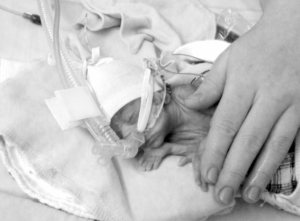 | Gunnar Moa and Kjell Nilsson invented and manufactured the first modern variable flow CPAP system. The results were published 1992 and Karolinska University hospital with Hugo Lagercrantz was one of the early adopters. (Moa, 1988) The system was bought by EME, UK and the first commercial generator was released 1991 as Infant Flow. The system was first driven by a standard rotameter and pressure monitor. The first driver was released 1993. Kjell Nilsson (Gunnar Moa) was involved in the first study of nebuliser surfactant (Berggren). The trial was negative and used non synchronised jet nebulisation with a jet nebuliser (Berggren, 2000). |
 |
Baldvin Jonsson moved from Washington D.C. to Stockholm 1988 and started to work with CPAP research together with Hugo Lagercrantz. The thesis titled Chronic Lung disease of prematurity was published 1998. The interest for the Scandinavian approach with NCPAP support to avoid intubation is increasing after Avery’s publication of low BPD at Columbia (1987). |
 | Thomas Drevhammar and Kjell Nilsson restarted the Östersund NCPAP research 2008 with the aim of nebulising surfactant. The Infant Flow project had been idle for more than ten years and the patents owned by a US firm were about to expire. Baldvin Jonsson accepted Thomas Drevhammar as his PhD student 2009. The work started with comparisons of nCPAP systems in a mechanical lung model. These identified high resistance to spontaneous breathing in the most common resuscitation system (T-piece). A parallel project of investigating the flow dynamics of the Infant Flow system was started with KTH, Stockholm. The work with nebulising drugs in NCPAP using filter deposition studies of Technetium was started in 2012. |
 | The poor performance of T-piece resuscitation systems were identified and the work of of developing an improved system was started 2010. A pilot trial of the new system in infants was started in 2012 at Karolinska, Stockholm. Snorri Donaldsson, neonatologist joins the group for the pilot trial and become the second PhD student 2014. The rPAP was patented by Neores to secure future research and facilitate contract with a manufacturer. An exclusive license with Inspiration Healthcare lead to CE-marking 2015. In the pilot trial the clinical impression was that prongs together with low resistance to breathing was advantageous. This hypothesis led to planning of the CORSAD trial. Planning of a large RCT was started in 2014. After CE-marking the academic CORSAD trial was started by our research group (2015). This non-company funded trial will recruit 250 infants <28 weeks gestational age. The primary outcome is delivery room intubation and the power calculation were on NNT of 5 which is very low. It is expected to be completed in 2019. |
 | The work with NCPAP in mechanical lung models continued to generate ideas for clinical research and solid data on CPAP performance. The work started with spontaneous breathing models, continued with ventilators and then positive pressure ventilation (PPV). From the start 2009 the work expanded to also include measurement of flow and breathing, nebulisation and oxygen delivery. The research group has also worked with CPAP for low and middle income countries. |
 | The research group has conducted four clinical trials. Three are directly related to the new resuscitation system starting with a feasibility trial and the seven center CORSAD trial. We closed our latest feasibility trial, the FUIRST trial, on transition and stabilisation directly at birth including skin-to-skin stabilisation in 2023. The work on measuring flow and leakage resulted in the ToNIL trial, a randomised cross-over comparison of two interfaces in 50 infants on CPAP. |
 | The research group continued to thrive with Baldvin Jonsson appointed professor emeritus 2023. We have two PhD students and Sonja Baldursdottir with defend her work 2023 and Kolbrun Gunnarsdottir 2024. Markus Falk and Snorri Donaldsson continue to work as post-docs within the group and Thomas Drevhammar became Docent in 2021. The work on non-invasive respiratory support have continued but the focus has expanded to CPAP for low and middle income countries, positive pressure ventilation and oxygen delivery. We have active collaborations with several research groups internationally. |